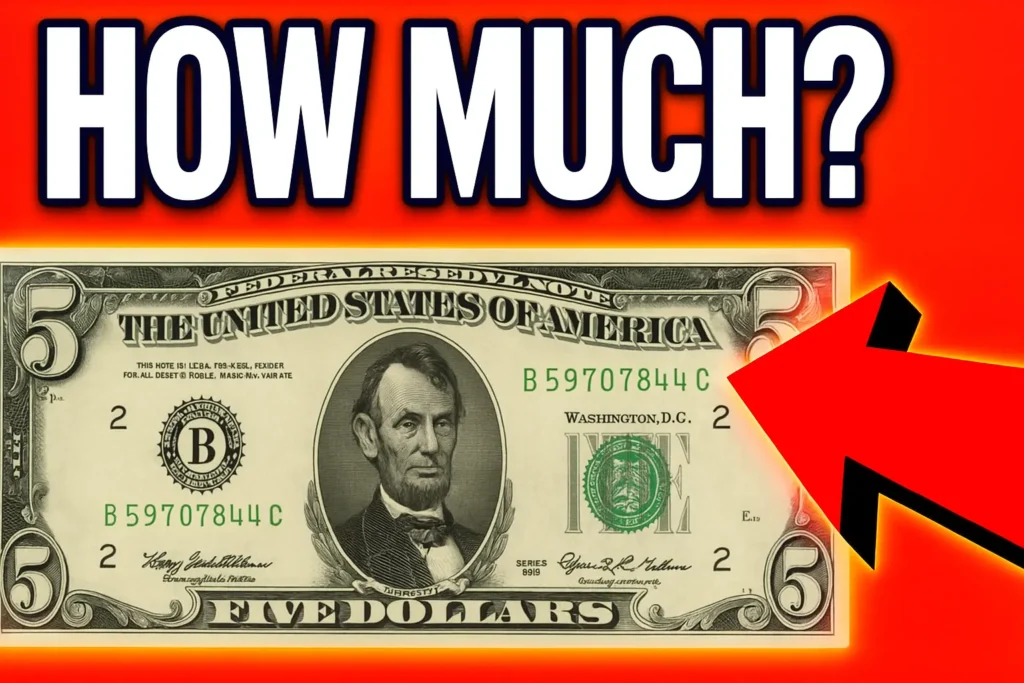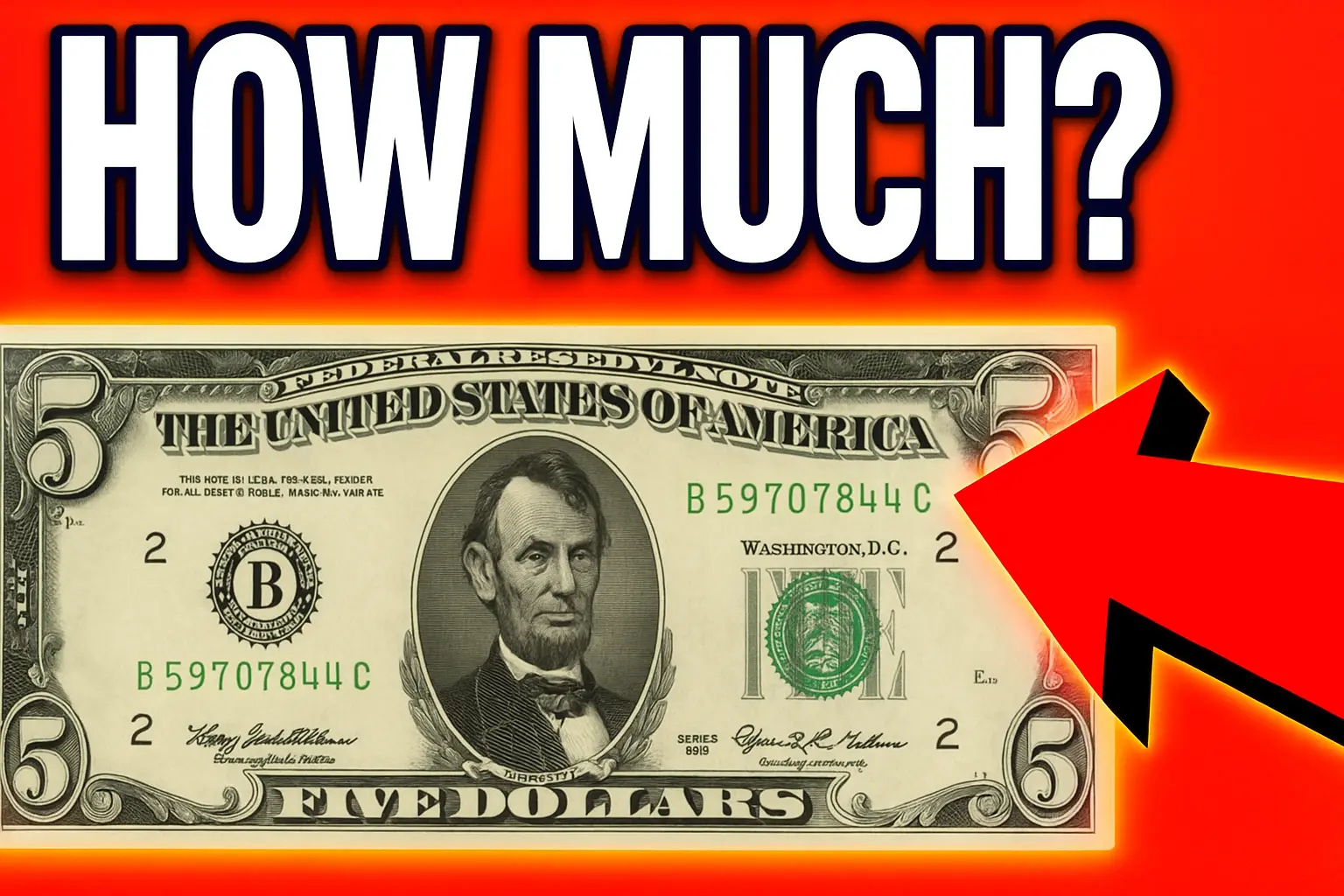If you have a few old bills tucked away in a wallet or drawer, it might be time to take another look. A rare 1995 $5 bill with an upside-down Treasury seal has become one of the most talked-about currency errors in America — and collectors are paying thousands for it. What looks like a simple $5 note could actually be a small fortune hiding in plain sight.

What Makes the 1995 $5 Bill So Valuable
In 1995, the Bureau of Engraving and Printing (BEP) produced millions of $5 Federal Reserve Notes. But during one specific print run, a rare error occurred: the green Treasury seal on some notes was printed upside down. The mistake slipped past inspectors and entered circulation unnoticed.
Also Read : Top 10 Rare U.S. Coins Collectors Are Desperately Hunting for in 2025
Unlike minor ink smudges or alignment errors, the upside-down seal is instantly recognizable — and extremely rare. Only a few sheets escaped into the public, making these bills highly sought after in the collector community.
Also Read : Your Pocket Change Could Contain a Rare 1999 Quarter Worth $10,000
The error happened because the overprint sheet — which adds the green Treasury seal and serial numbers — was accidentally fed into the press backward. When discovered, the BEP destroyed the remaining faulty sheets, but a small batch had already made its way into circulation.
Also Read : $5108 Stimulus Payment for Seniors – November 2025 Full Payment Schedule
How to Identify the Upside-Down Seal
Finding one of these bills is surprisingly simple if you know what to look for. Here’s how to spot the rare version:
- Series Year: It must say “Series 1995” near Lincoln’s collar.
- Upside-Down Treasury Seal: The green seal on the right of Abraham Lincoln’s portrait will appear completely inverted or rotated 180 degrees.
- Normal Serial Numbers: The serial numbers will look correct — only the seal is flipped.
- Federal Reserve Letter: Most known examples come from the “E” (Richmond) and “L” (San Francisco) districts, but others may exist.
Hold the bill under a good light and look closely at the green seal. If it appears upside down relative to the portrait, you may be holding one of the rarest modern U.S. paper money errors ever released.
How Much Could It Be Worth
The value depends on the note’s condition, rarity, and collector demand. According to current numismatic data and verified auction sales:
- Worn, circulated examples typically sell for $300–$800.
- Lightly circulated or crisp bills can reach $1,000–$2,500.
- Professionally graded uncirculated bills have fetched $3,000 or more.
Collectors prize these notes not only because of the visible error but because they’re easy to authenticate — no microscopes or UV lights required. If the seal is upside down, it’s almost certainly genuine.
How to Protect and Sell Your Bill
If you believe you’ve found a 1995 $5 bill with this rare misprint, handle it carefully.
- Don’t fold or flatten it. Condition is critical.
- Use a clear plastic currency sleeve — available from any coin or collectible store.
- Get it authenticated by a reputable service like PMG (Paper Money Guaranty) or PCGS Currency.
- Sell through reputable auction houses like Heritage Auctions or Stack’s Bowers, or online platforms that cater to verified collectors.
Avoid social media “cash buyers” or unverified online offers — scammers often target people who don’t know the value of their notes.
Why Errors Like This Are So Rare Today
Modern printing technology at the BEP makes large-scale errors nearly impossible. Today’s systems automatically detect misaligned sheets and reject them before they leave the press. That’s why genuine vintage printing errors from the 1980s and 1990s — like this upside-down seal — are in such high demand among collectors.
Because the 1995 series was among the last before the major 1996 currency redesign, it represents a closing chapter in an era of traditional printing, which adds to its nostalgic and collectible value.
Quick FAQ
Q1. How do I know if my 1995 $5 bill is rare?
Check if the green Treasury seal to the right of Lincoln’s portrait is upside down. If so, it’s a confirmed error note.
Q2. What is the current market value?
Depending on condition, prices range from $300 to over $3,000 in collector markets.
Q3. How can I authenticate it?
Submit it to PMG or PCGS Currency for grading and certification before selling.
Q4. Where can I sell it safely?
List it through professional currency auctions or verified platforms like Heritage Auctions or eBay’s Collectibles section with certification details.
Disclaimer: This article is based on verified auction results and numismatic reports as of October 2025. Values and availability may change with collector demand. Always verify through certified grading services or official U.S. Treasury resources before selling any rare currency.
